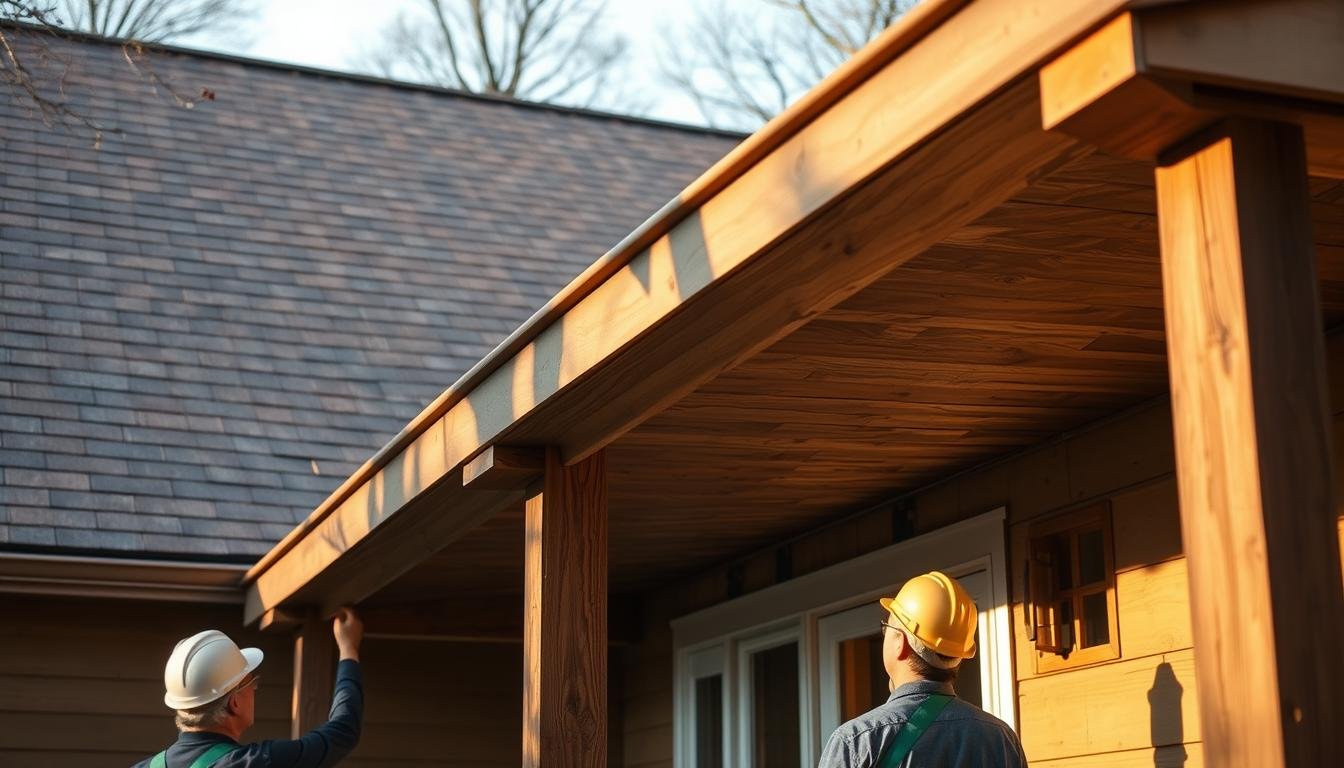Adding a porch roof to your existing one can make your space better. It also makes your home look nicer. This guide shows you the steps needed—from planning to adding final touches. It ensures your outdoor improvement is done well and safely.
Keep in mind, that 70% of DIY projects end up with some unexpected damage. Also, over 160,000 people go to the ER every year in the U.S. because of ladder accidents. So, it’s very important to be careful and know what you’re doing when starting this kind of project.
Key Takeaways
- Avoid DIY pitfalls that lead to property damage and increased injury risks.
- Secure necessary building permits to avoid fines.
- Employ the correct rafter size and roofing materials to ensure structural integrity.
- Consider hiring a professional contractor to minimize project risks.
- Use proper support columns to handle the weight of the porch roof.
Ready to learn more? Check our complete guide on how to tie a porch roof into an existing one. You’ll find expert advice and step-by-step instructions.
Understanding the Basics of Porch Roof Installation
Starting a porch roof project means learning some basics first. Think about your current roof and what the new porch roof needs. The design of roof joists and their ability to support weight is key. In snowy places like the Sierra Nevada, roofs must handle extra weight.
Planning isn’t just about building. Your design needs an engineer’s approval to follow local building laws. A bad installation can lead to mold or rot. Fixing these issues might cost over $10,000. But, you can avoid these problems with the right installation methods.
When thinking about the roof’s slope, a low pitch might need 2×6-foot rafters. But matching your home’s roof could need a different size. Using the same materials as your house is often best. It keeps the look and structure consistent.
Adding a porch roof means fixing a board over the slope of your current roof. Gable roofs are popular because they’re easy to keep up. For flat roofs, use a rubber layer to stop leaks. To prevent water damage, put underlayment over the main roof and use metal flashing.
Knowing these basics helps with your project. But, 40% of homeowners don’t check material details with manufacturers. This oversight can cause problems. Planning well and using the right techniques reduce risks like extra weight on your roof.
Finally, there are three ways to add a porch roof to your house. You can connect it to the wall, fascia, or use roof extension brackets. Each method meets different needs. Pick the right one for a sturdy and lasting porch roof.
Preparing Your Workspace and Materials
Start by making your workspace ready and setting up your materials. This is key for a smooth project. First, clean up your space to ensure it’s safe and you can work efficiently. Knowing the local building rules is also vital to avoid problems. Getting ready properly can cut your time and costs by 20%.
You’ll need to collect some specific tools and materials. Among these are rafters, beams, cleats, and things for weather protection like ice and water shields. Don’t forget your measuring tape, saws, and hammers for accurate work. Using strong screws and brackets will make the roof stable and safe, lowering the risk of problems by 30%.
Consider which materials you’ll use for the roof. Asphalt shingles are popular because they’re cheap and easy to put on. If you want something tougher, think about metal roofing or cedar shakes. Keeping all materials organized and close by helps with a smooth installation. This care also makes your materials last longer.
Create plans that detail each step of your project. Having a plan helps keep things organized and ensures you don’t miss anything. Getting help from a pro or advice from experts is a good idea for tricky parts. It can cut down on mistakes by as much as 50%.
Checking your existing roof is also a critical step. Look at the slope and frame to see if everything matches up. Bad planning can cause big problems later. Adding extra supports like collar ties can strengthen the roof, helping it hold up better.
Essential Tools and Materials Checklist
| Tools | Materials |
|---|---|
| Measuring Tape | Rafters |
| Level | Beams |
| Saws | Cleats |
| Hammer | Screws |
| Brackets | Roofing Shingles |
| Lag Screws | Sheathing |
| Metal Brackets | Ice and Water Shield |
Finally, get all permits and approvals before you start. This varies by location but is crucial for legal compliance and avoiding delays. Putting in the effort to get ready well sets the stage for a smooth and successful project.
Assessing Your Current Roof Structure
Integrating a new porch roof with your house requires a careful roof structure assessment. This check ensures your current roof can hold the extra weight safely.
Checking your existing roof involves looking at the roof joists and sheathing. These must support the dead and snow load. The maximum dead load is often about 1500 pounds per square foot (psf). The snow load for a specific area might be around 20 psf.
For a 100 square foot roof that needs to bear both loads, the total load would be 3000 pounds. This is made up of 2000 pounds from snow and 1000 pounds from the dead load. It’s important to have strong supports for this weight. Normally, you’d need at least 2 square feet of footing area for 3000 pounds.
| Load Type | Measurement | Example Calculation (100 sq. ft.) |
|---|---|---|
| Dead Load (DL) | 1500 psf | 1000 lbs |
| Snow Load (S) | 20 psf | 2000 lbs |
| Total Load | – | 3000 lbs |
| Minimum Footing Area | – | 2 sq. ft. |
It’s best to use columns that go 3 feet into concrete for support. A good mix is four 4×6 columns and nine 6×6 columns. This setup helps spread out the weight and keeps the structure stable.
Besides straight down weights, it’s important to calculate side and twisting forces. Though not part of the standard load check, they’re key for making sure the structure stays sound. The materials used and the design depend on local rules, which aim to keep the porch safe and last a long time.
If loads are not figured out right, you might see trusses break, foundations crack, or walls buckle. Planning for the worst, like heavy snow or strong winds, is crucial. For more tips, check out our guide on connecting a porch roof to a house.
Step-by-Step Guide to Tying in Your Porch Roof
Starting a porch roof project means you need a good plan and attention to detail. We’ll show you how to make sure your new porch roof looks great and is strong.
First, take off the old shingles where you’ll connect the porch roof. This is a key step. You’ll put cleats on the existing roof joists. Make sure the new joists fit perfectly by notching them. Use glue and screws to make them secure and long-lasting.
- Ledger Attachment: Use a standard ledger to support the porch roof rafters. It’s usually made from 2 by 6 lumber. The best way to attach it is with bolts that go through the ledger, house, and rim joist, secured with nuts and washers. For lag screws, use 1/2-inch ones spaced every 16 inches.
- Weatherproofing: To make your roof last, use properly capped galvanized metal Z-flashing. If you attach the ledger to wood siding, put stainless-steel washers in between for water drainage.
- Reapplying Shingles: After securing the structure, put shingles back on. This blends the old and new parts of the roof and keeps water out.
| Component | Specification | Details |
|---|---|---|
| Ledger Connection | Bolts or Lag Screws | Bolts with washer and nuts; 1/2-inch lag screws spaced 16 inches apart |
| Flashings | Galvanized Metal Z-Flashing | For preventing water seepage |
| Support Posts | Spacing | Less than 8 feet apart |
| Roof Rafters | Installation | Hand-framed; 16 inches on center along the ledger |
| Anchor Bolts | Expanding | Every 16 inches for masonry walls |
Follow these steps to avoid problems and get a high-quality roof finish. Every part of the process is important. From removing shingles to weatherproofing and putting them back on, each step helps make your porch roof strong and good-looking. Doing it right means less maintenance later and a porch that lasts for years.
Finishing Touches for a Professional Look
As you wrap up your porch roof project, paying attention to the finishing touches is key. Properly aligned shingles not only look good but extend the roof’s life.
It’s vital to check the weatherproofing of your new porch roof. This means making sure the flashing is correctly installed to stop water leaks. Waterproofing and insulation are crucial for energy efficiency and comfort.
The look of your porch roof matters too. Adding siding, paint, and trim can make it blend with your home. This improves your home’s look and can raise its value.
Here’s a breakdown of the costs you might see:
| Deck Feature | Average Cost Range | Benefits |
|---|---|---|
| Cover Deck | $1,000 – $10,000 | Provides shade, protection from weather |
| Add Roof to Deck | $3,000 – $10,000 | Enhanced durability, improved aesthetics |
| Patio Roof | $2,000 and up | Increases usability of outdoor space |
| Shed Roof | $1,000 – $10,000 | Simple design, cost-effective |
After the major work is done, clean the area for safety and neatness. Checking your work thoroughly is important for a professional finish. Make sure everything is secure and aligned.
Considering the detail involved in roof installation, consulting experts like architects is wise. They help ensure your project meets local codes and standards. This extra step prevents future issues and secures quality.
Maintenance Tips for Your New Porch Roof
A well-maintained porch roof lasts longer and looks great. It’s key to avoid expensive repairs and structural problems. Here are some top tips for keeping your porch roof in top shape.
Start by checking your roof regularly for loose or damaged shingles. Say you’re using IKO Advantage Size Laminated Shingles with a 5 7/8-inch exposure. You’d then ensure the step flashing is 10 x 8 inches. Because incorrect flashing can lead to leaks, it’s important. Make sure each flashing piece is nailed down properly but allows for movement.
Keeping gutters clean is also crucial. It prevents water damage to your roof and its structure. In places like Florida, you might need special roofing tape for water control. Also, after storms, clear away any debris to keep water flowing correctly.
Don’t forget to manage snow build-up in the winter, as it can be too heavy. Proper flashing, which should extend 8 to 14 inches above the shingles, can stop moisture damage. The National Roofing Contractors Association (NRCA) recommends this. Use asphalt plastic cement for a secure, waterproof flashing seal. With these maintenance steps, your porch roof will be safe, sound, and looking good.




